
Since the launch of OpenAI’s latest image generator, AI-generated images in the style of Studio Ghibli have flooded the internet. Users are flocking to create Ghibli versions of themselves, but beneath this viral trend lie pressing questions about copyright, transparency, and the environmental impact of AI technology. VUB experts Andries Rosseau and Prof. Dr. Rob Heyman analyse the situation.
Read the full article (in Dutch) on VRT NWS, published on 1st April 2025 by Mariska Schalck.
Andries Rosseau, a PhD student at VUB, highlights the impressive precision of the latest model. “The model now understands much better what is being asked and can generate far more accurate images than its predecessors.” This leads to remarkable results, but it also raises questions about how the AI has been trained to such a high standard.
According to Rosseau and Heyman, such accuracy is almost certainly impossible without using existing Studio Ghibli images. However, OpenAI has not disclosed exactly what data was used, and this lack of transparency fuels the debate about intellectual property. “Anime is a rich source of visual material, but without openness, it remains unclear whether OpenAI is violating copyright,” says Heyman.
A Legal Grey Area
For now, there is little that original creators can do. AI companies are not required to disclose their training data, and legislation is lagging behind. Rosseau points out that major players show little motivation to adapt, meaning change will likely have to come from legislation. The European AI regulations, which are being phased in, could potentially bring about such change. Heyman sees this as a possible step forward: “Foundational models could be required to disclose their sources.” But will OpenAI, an American company, pay any heed to European regulations?
The True Cost of Generative AI
In addition to the legal issues, the environmental impact is also significant. The enormous computing power behind AI models demands vast amounts of energy, yet OpenAI provides no insight into how this is managed. “Every query can consume considerable energy, but users rarely consider that,” stresses Heyman.
Furthermore, artists are not receiving the ‘true price’ for their work. “Anyone generating a Ghibli-style AI image should actually be compensating the original creators,” says Heyman. In the US and the UK, there are even calls to allow protected works to be freely used for AI training, which would further skew the power balance between companies and artists.
The debate around AI and copyright will only intensify in the coming years. Transparency, regulation, and fair compensation are at the heart of the conversation. Those keen to see themselves in Ghibli style would do well to also consider the broader impact of this technology.*
*This is a machine translation. We apologise for any inaccuracies.